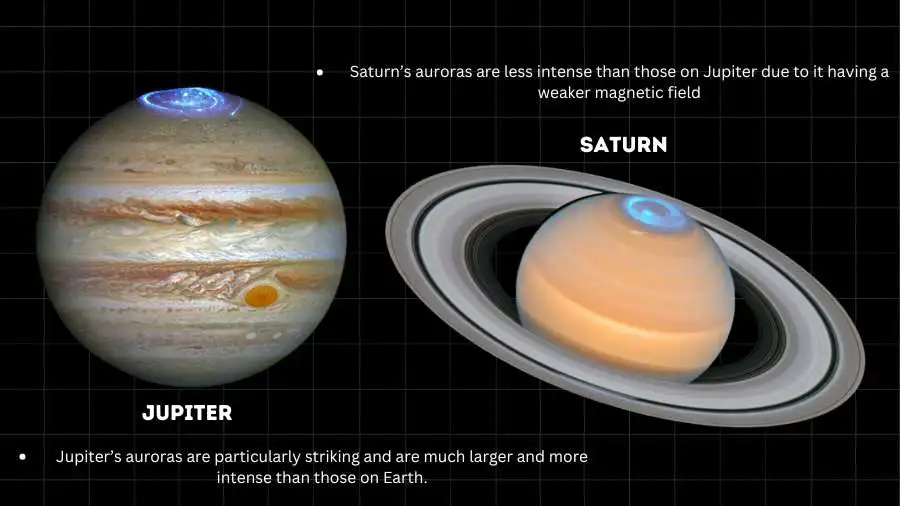Auroras, or the northern and southern lights, is a colorful plasma phenomenon occurring near the Earth’s poles due to the interaction between the solar wind and the Earth’s magnetic field. It is also known as Holy Grail of skywatching.
What Causes The Aurora Borealis?
Charged particles from the Sun (solar wind) collide with air molecules (oxygen and nitrogen) in the Earth’s upper atmosphere, exciting these molecules, typically during geomagnetic storms caused by strong solar activity and resulting in the emission of light.
Auroras typically occur between 60 and 75 degrees latitude and at altitudes of 80 to 500 km above the Earth’s surface. They are more frequent in these regions due to the concentration of the Earth’s magnetic field lines, which channel the solar wind particles toward the poles.
Observing Northern Lights
Auroras are best observed at midnight in cold winter conditions with clear, dark skies because such conditions maximize visibility by reducing atmospheric interference and light pollution. High-energy electrons and other charged particles from solar activity collide with upper atmospheric molecules at these high altitudes, transferring energy and exciting the molecules to emit light, which creates the auroras.
These charged particles move through space at different speeds, and after a few days, some come into contact with the Earth’s magnetic field, or magnetosphere. At this point, they are channeled toward the north and south magnetic poles into areas known as the Auroral Ovals. This phenomenon is influenced by the energy of the Sun’s activity, which collides with atmospheric molecules to form new high-energy states.

Since auroras, are closely linked to the space environment, including the presence of celestial bodies, radiation, and particle reflection. The Sun, Earth, and Moon, in particular, play key roles in this process. The Moon, a solid body without a magnetic field, reflects sunlight, making it visible from Earth at night.
The Earth reflects sunlight and has a complex structure comprising a core of heavy metals, a fluid mantle, a crust of lighter materials, and an atmosphere up to 1000 km thick. Weather occurs in the troposphere, while auroras form in the ionosphere, where the thermosphere’s high temperatures and low concentration of water vapor facilitate the interaction between energetic ions and charged particles from the Sun.
This interaction at the Earth’s poles leads to the formation of auroras. Historically, auroras could only be observed by the naked eye from the ground. In recent decades, satellites have become crucial in observing auroras and analyzing their ion-electron energy distributions. Satellites equipped with ultraviolet scanning imagers have captured images of the Aurora Borealis and Aurora Australis.
Related: What are Coronal Mass Ejections? Origin and Detection
Auroras on Other Planets
Similar oval-ring auroras were also observed on Jupiter and its moons by the Galilean satellites. The non-uniform brightness of the oval-ring auroral arc is influenced by various factors, including geomagnetic activity, solar wind conditions, and the distribution of charged particles in the Earth’s upper atmosphere.

Saturn’s auroras are caused by interactions between charged particles and the planet’s atmosphere. However, they are less intense than those on Jupiter because Saturn has a weaker magnetic field.
Since we are currently in the 25th solar cycle’s solar maxima, when solar activity is most likely to be increased and aurora displays can be rather spectacular, now is the ideal time to witness this phenomenon. Since the next solar maxima won’t occur for another 11 years, don’t miss out this opportunity to admire their beauty.
Various forms of Auroras
At first, an auroral display may appear as a greyish light with a hint of green, typically forming a greenish arc in the northern sky, occasionally with rays extending upwards like searchlight beams. Over time, this arc can evolve into various striking forms, such as a winding auroral ribbon or band that traverses the Arctic sky and changes shape rapidly.
Sometimes, these rays rise high into the Arctic sky and converge overhead, resulting in one of the most dramatic auroral shapes: the corona, or crown, which looks like a firework bursting and descending above you.
Auroras emit excess energy as different colors of light
The green and rosy red hues of auroras are caused by excited oxygen atoms. Green is the most prevalent aurora color because the human eye is particularly sensitive to the green spectrum. According to the Canadian Space Agency (CSA), green auroras generally occur when charged particles collide with high concentrations of oxygen molecules in Earth’s atmosphere at altitudes between approximately 60 and 190 miles (100 to 300 kilometers).
Red auroras are less common and are typically linked to strong solar activity. They form when solar particles interact with oxygen at higher altitudes, usually between 180 and 250 miles (300 to 400 kilometers), as noted by the Canadian Space Agency (CSA). At these elevations, oxygen is less concentrated and is excited at higher frequencies or wavelengths, which makes the red colors visible. Red auroras are often observed at the upper edges of the auroral display.
Nitrogen, another major component of Earth’s atmosphere, is more difficult to excite. Nitrogen atoms typically need to be struck very forcefully or exposed to ultraviolet light to become excited. The background purple or mauve color in auroras is caused by excited nitrogen atoms at altitudes of around 250 to 400 kilometers above the ground. Blue and purple auroras are even rarer and usually occur during high solar activity. These colors result from solar particles colliding with nitrogen at altitudes of 60 miles or less, and they are often visible in the lower regions of the auroral display.
Yellow and pink auroras are uncommon and generally linked to intense solar activity. These colors occur when red auroras mix with green or blue auroras. Excited nitrogen atoms can also create the stunning lilac-pink color seen in the most vibrant auroral displays, where particles penetrate to altitudes between 95 and 100 kilometers above the ground. Additionally, nitrogen excitation can produce turquoise or deeper blue shades.
Auroral colors can seem faint to our eyes. It’s recommended to view auroras at twilight, as the sky’s brightness helps activate our color sensors. As the sky darkens, the colors may become harder to see unless the aurora intensifies. The visibility of the colors largely depends on how our eyes perceive them in low light.











Comments 2